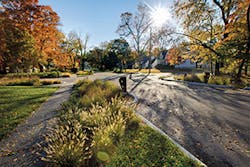Editor’s note: this article first appeared in the July/August 2015 issue of Stormwater.
Much of the country’s original infrastructure is 50 years old or older, and a lot of it is in desperate need of repair or replacement. “Aging is a huge issue,” confirms Brian DePonte, editorial contact with Key Equipment Finance, an affiliate of KeyCorp. that provides business-to-business equipment financing solutions. “A lot of infrastructure was built as WPA [Works Progress Administration of the New Deal] projects. It’s crumbling now.”
He quotes an assessment by the American Water Works Association (AWWA) estimating that $1 trillion is needed to address the problem. That sum creates another problem: where to get the money to pay for fixing our aging, crumbling infrastructure.
Lack of funding can be an obstacle for these projects. While they generate numerous benefits, they often compete for what diverse funding sources are available. “Foundations, endowments, etc. like to be green investors,” states Lauryn Agnew, principal at Seal Cove Financial. “There are social and governmental factors attached to the greenness of projects. Everyone is thinking about their carbon footprint.”
Paying it Forward
Concern about the effects of climate change has brought emphasis to the importance of investment in green infrastructure. Scientific research and documented evidence have established that greenhouse gas emissions from increasing economic activity have led to global warming. It is believed that if temperatures remain within 2°C of pre-industrial temperatures, most of the negative impacts of climate change can be circumvented. That effort will require massive amounts of money to develop the necessary technology.
Few seem to comprehend the enormous sums of money needed to halt the calamitous trajectory. A report by Standard and Poor estimates that investments in infrastructure of over $2.5 trillion per year would be required to keep temperatures from rising.
In the book Green Infrastructure Finance: Leading Initiatives and Research, authors Aldo Baietti, Andrey Shlyakhtenko, Roberto La Rocca, and Urvaksh D. Patel reference estimates by the International Energy Agency that indicate a 50% reduction in carbon dioxide emissions by 2050 would require global investments in the energy sector of $750 billion a year by 2030 and over $1.6 trillion a year from 2030–2050.
Current investments fall far short of that, despite global efforts to mobilize capital flow. According to Bloomberg New Energy Finance, by 2020 investments will be $150 billion short of the levels required simply to stabilize CO2 emissions, writes Baietti, adding that for the East Asia and Pacific region alone, the World Bank study “Winds of Change” suggests that additional investments of $80 billion a year over the next two decades are required.
DOE and EPA
The benefits of green infrastructure are documented. However, despite the trendiness of the issue, green projects are still not always easy to fund. One of the early backers of these projects was the government. Federal tax incentive programs are the government’s way of encouraging green infrastructure by attracting financing for municipal projects.
The Department of Energy (DOE) administers several energy efficiency tax incentives, into which green infrastructure could be integrated. For example, in Eugene, OR, a new biofuel station built on an abandoned gas station site includes a green roof, bioswales, and rain gardens. Taking advantage of Oregon’s Energy Efficiency Construction Credits, the private company that built and operates the project earned nearly $250,000 worth of tax credits.
EPA provides several federal sources of funding for green infrastructure projects. To help local stormwater managers understand available funding options for local programs, EPA provides comprehensive guides, case studies, and training materials gathered from several government and nonprofit organizations.
Despite EPA’s efforts, though, funding for stormwater management infrastructure is limited, with dwindling federal and state resources designated to support green infrastructure investment. As an increasing regulatory presence creates demands for improvement, a vacillating economic climate fails to keep pace, leading to funding gaps.
The federal government isn’t the only source of green infrastructure financial aid. When public sector resources are scarce or committed to other projects, private investment must be leveraged. Innovative approaches are needed to reduce the cost burden on the public sector through private investment, incentive-based programs, and unique methods of utilizing public funds.
